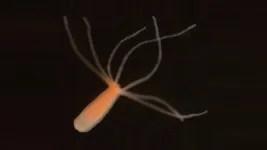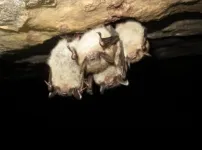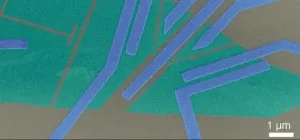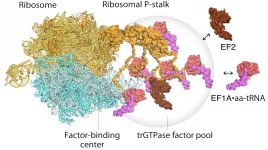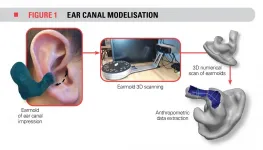(Press-News.org) Stay awake too long, and thinking straight can become extremely difficult. Thankfully, a few winks of sleep is often enough to get our brains functioning up to speed again. But just when and why did animals start to require sleep? And is having a brain even a prerequisite?
In a study that could help to understand the evolutional origin of sleep in animals, an international team of researchers has shown that tiny, water-dwelling hydras not only show signs of a sleep-like state despite lacking central nervous systems but also respond to molecules associated with sleep in more evolved animals.
"We now have strong evidence that animals must have acquired the need to sleep before acquiring a brain," says Taichi Q. Itoh, assistant professor at Kyushu University's Faculty of Arts and Science and leader of the research reported in Science Advances.
While sleeping behavior was also recently found in jellyfish, a relative of hydras and fellow member of the phylum Cnidaria, the new study from researchers at Kyushu University in Japan and Ulsan National Institute of Science and Technology in Korea found that several chemicals eliciting drowsiness and sleep even in humans had similar effects on the species Hydra vulgaris.
"Based on our findings and previous reports regarding jellyfish, we can say that sleep evolution is independent of brain evolution," states Itoh.
"Many questions still remain regarding how sleep emerged in animals, but hydras provide an easy-to-handle creature for further investigating the detailed mechanisms producing sleep in brainless animals to help possibly one day answer these questions."
Only a couple of centimeters long, hydras have a diffuse network of nerves but lack the centralization associated with a brain.
While sleep is often monitored based on the measurement of brain waves, this is not an option for tiny, brainless animals.
As an alternative, the researchers used a video system to track movement to determine when hydras were in a sleep-like state characterized by reduced movement--which could be disrupted with a flash of light.
Instead of repeating every 24 hours like a circadian rhythm, the researchers found that the hydras exhibit a four-hour cycle of active and sleep-like states.
More importantly, the researchers uncovered many similarities related to sleep regulation on a molecular and genetic level regardless of the possession of a brain.
Exposing the hydras to melatonin, a commonly used sleep aid, moderately increased the sleep amount and frequency, while the inhibitory neurotransmitter GABA, another chemical linked to sleep activity in many animals, greatly increased sleep activity.
On the other hand, dopamine, which causes arousal in many animals, actually promoted sleep in the hydras.
"While some sleep mechanisms appear to have been conserved, others may have switched function during evolution of the brain," suggests Itoh.
Furthermore, the researchers could use vibrations and temperature changes to disturb the hydras' sleep and induce signs of sleep deprivation, causing the hydras to sleep longer during the following day and even suppressing cell proliferation.
Investigating more closely, the researchers found that sleep deprivation led to changes in the expression of 212 genes, including one related to PRKG, a protein involved in sleep regulation in the wide range of animals, including mice, fruit flies, and nematodes.
Disrupting other fruit fly genes appearing to share a common evolutional origin with the sleep-related ones in hydras altered sleep duration in fruit flies, and further investigation of such genes may help to identify currently unknown sleep-related genes in animals with brains.
"Taken all together, these experiments provide strong evidence that animals acquired sleep-related mechanisms before the evolutional development of the central nervous system and that many of these mechanisms were conserved as brains evolved," says Itoh.
INFORMATION:
For more information about this research, see "A sleep-like state in Hydra unravels conserved sleep mechanisms during the evolutionary development of the central nervous system," Hiroyuki J. Kanaya, Sungeon Park, Ji-hyung Kim, Junko Kusumi, Sofian Krenenou, Etsuko Sawatari, Aya Sato, Jongbin Lee, Hyunwoo Bang, Yoshitaka Kobayakawa, Chunghun Lim, and Taichi Q. Itoh, Science Advances (2020). https://doi.org/10.1126/sciadv.abb9415
Since 2006, a fungal disease called white-nose syndrome has caused sharp declines in bat populations across the eastern United States. The fungus that causes the disease, Pseudogymnoascus destructans, thrives in subterranean habitats where bats hibernate over the winter months.
Bats roosting in the warmest sites have been hit particularly hard, since more fungus grows on their skin, and they are more likely to die from white-nose syndrome, according to a new study by researchers at Virginia Tech.
But instead of avoiding these warm and deadly sites, bats continue to use them year after year. The reason? Bats are mistakenly preferring sites where fungal growth is ...
An invisible flow of groundwater seeps into the ocean along coastlines all over the world. Scientists have tended to disregard its contributions to ocean chemistry, focusing on the far greater volumes of water and dissolved material entering the sea from rivers and streams, but a new study finds groundwater discharge plays a more significant role than had been thought.
The new findings, published January 8 in Nature Communications, have implications for global models of biogeochemical cycles and for the interpretation of isotope records of Earth's climate history.
"It's really hard to characterize groundwater discharge, so it has been a source of uncertainty in the modeling of global cycles," said first author Kimberley Mayfield, who led the study as ...
Pleiotropy analysis, which provides insight on how individual genes result in multiple characteristics, has become increasingly valuable as medicine continues to lean into mining genetics to inform disease treatments. Privacy stipulations, though, make it difficult to perform comprehensive pleiotropy analysis because individual patient data often can't be easily and regularly shared between sites. However, a statistical method called Sum-Share, developed at Penn Medicine, can pull summary information from many different sites to generate significant insights. In a test of the method, published in Nature Communications, Sum-Share's developers were able to detect more than 1,700 DNA-level variations that ...
A joint group of scientists from Finland, Russia, China and the USA have demonstrated that temperature difference can be used to entangle pairs of electrons in superconducting structures. The experimental discovery, published in Nature Communications, promises powerful applications in quantum devices, bringing us one step closer towards applications of the second quantum revolution.
The team, led by Professor Pertti Hakonen from Aalto University, has shown that the thermoelectric effect provides a new method for producing entangled electrons in a new device. "Quantum entanglement is the cornerstone of the novel quantum technologies. This concept, however, has puzzled many physicists over the years, including Albert Einstein who worried a lot about the ...
Reactive molecules, such as free radicals, can be produced in the body after exposure to certain environments or substances and go on to cause cell damage. Antioxidants can minimize this damage by interacting with the radicals before they affect cells.
Led by Enrique Gomez, professor of chemical engineering and materials science and engineering, Penn State researchers have applied this concept to prevent imaging damage to conducting polymers that comprise soft electronic devices, such as organic solar cells, organic transistors, bioelectronic devices and flexible electronics. The researchers ...
Jan. 8, 2021 - A new study published online in the Annals of the American Thoracic Society examines the recovery of lung function and overall wellness in individuals who had varying degrees of COVID-19 severity. Little is known about lung health following infection with SARS-CoV-2, the virus that causes COVID-19, and whether later respiratory problems, fatigue and ill health are associated with the disease's initial severity.
In " END ...
Researchers from Oklahoma State University, University of Missouri, Iowa State University, and University of Georgia published a new paper in the Journal of Marketing that investigates the question of how salespeople should balance advocacy for the seller with advocacy for the customer.
The study, forthcoming in the Journal of Marketing, is titled "Salesperson Dual Agency in Price Negotiations" and is authored by Justin Lawrence, Lisa Scheer, Andrew Crecelius, and Son Lam.
How should salespeople represent both the seller and the customer when their interests diverge, as in pricing negotiations? The research team extends a dual agency framework to the sales domain and examines the salesperson's role throughout the three stages of the discount process: (a) the ...
Ribosomes are the complexes of ribonucleoproteins at the heart of protein synthesis in cells. However in the absence of conclusive evidence, how these complexes operate has been open to debate. Now Hirotatsu Imai and Noriyuki Kodera at Kanazawa University, alongside Toshio Uchiumi at Niigata University in Japan, show visualizations of the structural dynamics and factor pooling that take place at ribosome stalk proteins as they build new proteins.
Ribosomes were first discovered in the 1950s and their broad function has been widely understood for some time - they read messenger RNA sequences and from that generate sequences of correctly ordered amino acids into new proteins. The ribosome stalk protein in particular plays an ...
Noise exposure accounts for 22% of worldwide work-related health problems. Excessive noise not only causes hearing loss and tinnitus, but also increases the risk of cardiovascular diseases. To provide protection, workers normally wear earplugs. However, commonly available earplugs are often uncomfortable, since they don't fit everyone's ears equally well.
How could we improve the comfort and effectiveness of these earplugs? What aspects of the ear canal must be taken into account? To answer these questions, researchers from the École de technologie supérieure (ÉTS University) and the Institut de recherche en santé et sécurité ...
Non-violent offenders serving time for drug use or possession should be freed immediately and their convictions erased, according to research published in the peer-reviewed The American Journal of Bioethics.
More than 60 international experts including bioethicists, psychologists and drug experts have joined forces to call for an end to the war on drugs which they argue feeds racism.
All drugs currently deemed illicit - even crack cocaine and heroin - should be decriminalized as a matter of urgency, according to this new alliance. Legalisation and regulation should then follow with restrictions on age, advertising and licensing, they say.
They have analysed evidence from over 150 studies and reports, concluding that prohibition unfairly affects Black people, damages communities, ...
